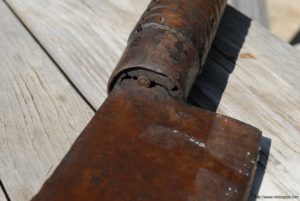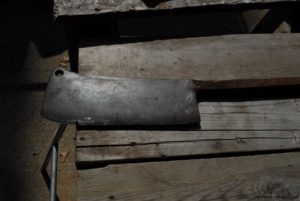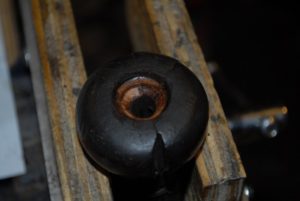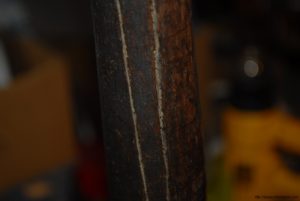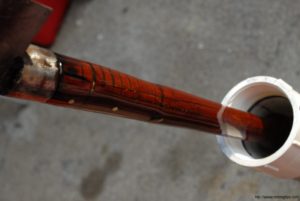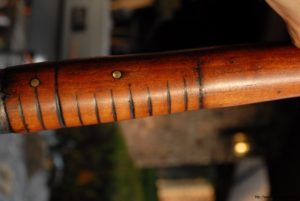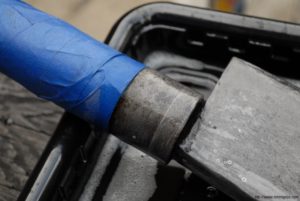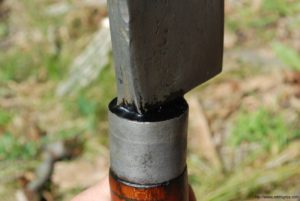| Some years back I wrote a post on how to find cleavers and figured it was time to update it with better search routines for eBay plus to add a few tips not in the original. |
One of my favorite things to do is to restore an old cleaver. I’ve done a ton of them over the years and posted many photos along the way. In response to the photos or sales listings in my online store, guys will ask how to find a good deal on one to restore themselves.
The best deal you’ll get is at garage, barn and estate sales – no two ways about that. Antique dealers usually jack their prices into orbit and I’ve not seen a good deal at an antique dealer in a long, long time.
My challenge is that I don’t have time to go hunting for stuff so I do a lot of automated searches on eBay. What I am going to do in this post is try and give you some tips plus also live searches of eBay using key words that frequently turn up cleavers to keep an eye on.
 This is a New Haven Edge and Tool Co Cleaver
This is a New Haven Edge and Tool Co Cleaver
That leads us to tip #1 on eBay – set up searches that email you when they find stuff. What you do is enter your search term on eBay and then click “follow this search”. EBay will then give you options for alerts and so forth. You can experiment and figure out what works for you. For me, for example, just searching on “cleavers” is useless because of all the junk that comes back so I keep refining my searches based on key words both to include and to exclude.
 This is a 16.5″ Foster Bros #8 – Fosters is another favorite brand
This is a 16.5″ Foster Bros #8 – Fosters is another favorite brand
Learn some of the phrases folks use to describe / market these big cleavers. No doubt, I like big cleavers so I use search phrases like “giant antique cleaver”, “giant hog splitter” and what not. In general, the hog and cow splitters are big. These huge cleavers were used in the days before extensive automation to chop up big farm animals such as cows, hogs, lambs and so forth giving them their name.
When searching, look in descriptions and not just the titles if given the option. You may need to use the advanced search option and add key words to exclude when things you don’t care about are included in your searches.
 This is a 16.5″ Lamson
This is a 16.5″ Lamson
There are also certain brands that I really like such as Fosters, WM Beatty, Lamson and New Haven Edge Tool Co. There were a lot of makers including folks on farms and village blacksmiths forging their own cleavers so it really takes some digging. I found searches on Google to turn up interesting information about the history of the makers and so forth when I could find some kind of logo or marking.
 This is a 20″ WM Beatty and Sons
This is a 20″ WM Beatty and Sons
Another tip I would give you is to look out for old cleavers that are shiny. Somebody probably sanded or ground the rust off. I have bought a couple that were utter train wrecks from guys trying to make something look good for sale. Just be careful. Nothing that was used is going to be bright silver steel any longer.
Do not worry about rust, dirt and dings – you are going to be working on it anyways. How far you want to go with the wood is up to you. The most fascinating cleaver I ever worked on had a trashed handled that I built up with epoxy. It was stunning wood under decades of grime.
Be careful on the measurements – look for the blade size and overall lengths plus the weight. I like to look for cleavers that are at least 18″ overall. Call be weird but the smaller ones are okay but just not as interesting to me. I do have an exception though – some of the small Fosters are just wicked. They were forged, have a thick blade and quite a heft.
Watch out for photos. Sellers try all kinds of stuff to make them look big, in great shape, etc. You are especially focused on whether the blade is intact, meaning no big nicks or any cracks, and the dimensions. The photos are nice eye candy but don’t base your whole purchase on them. I certainly use them to try and judge the condition of the blade. If a seller doesn’t have an angle you want to see, ask them to send you what you need. Many sellers will oblige these requests.
 Giant 24.5″ cleaver with a 1/2″ thick blade from an unknown maker – my all time favorite
Giant 24.5″ cleaver with a 1/2″ thick blade from an unknown maker – my all time favorite
Now be patient and don’t rush. Watch the prices these things are selling at and don’t start bidding until the last minute. Also keep an eye on the seller’s ratings. New ones with fewer than 20 sales make me nervous. Read what folks have to say about the seller.
Keep an eye on shipping charges. Some guys will do stuff like list something dirt cheap and then charge a fortune for shipping. Don’t just assume shipping & handling charges will be reasonable if it isn’t listed.
Be patient! You can get some very decent cleavers for under $100 but what you consider a fair price is entirely up to you.
Here are some realy time eBay Searches to help you get started using keywords I use in my own searches and you can buy these right now!! Note that some sections may be empty if there are no current matches,
Giant Antique Cleaver
There will be times you want to qualify a search phrase and “antique cleaver” is one of them. If you search on that you will get matches for things people call cleavers that are just a few inches long. When sellers have a big cleaver they tend to use words like HUGE or GIANT in their description. Of course, most will not be very big but it is something to look for. Let’s try “giant antique cleaver” first:
Next is “huge antique cleaver”
Hog Splitter
This one is searching on “Hog Splitter” and excuding the words “stereo plug mono” because some stereo cords get matched and would be included otherwide.
Cow Splitter
True clow splitters are rare so when you search on eBay you will often get quite a few near matches from their search engine and wind up with a long list of things to exclude such as “witchblade stereo cord wind extender cable engine cent paring comic glove knob”.
Beatty Cleaver
Beatty cleavers come in a variety of sizes from small to big splitters so be sure to carefully read the description. Sometimes the photos make them look bigger than they really are.
Foster Cleaver
Fosters are also very good cleavers. They made a bunch of different models to read the description carefully.
Antique Cleaver
Just to show you what antique cleaver sucks in, here you go:
Vintage Cleaver
Large Vintage Cleaver
I hope these tips and sample search terms help. My biggest tips are to carefully read the descriptions, consider the seller’s ratings carefully and watch out for shipping. Also, don’t rush and get caught up in auction fever – only buy what makes sense to you.
Happy hunting!!
If you find this post useful, please share the link on Facebook, with your friends, etc. Your support is much appreciated and if you have any feedback, please email me at in**@*********ps.com. Please note that for links to other websites, we are only paid if there is an affiliate program such as Avantlink, Impact, Amazon and eBay and only if you purchase something. If you’d like to directly contribute towards our continued reporting, please visit our funding page.











